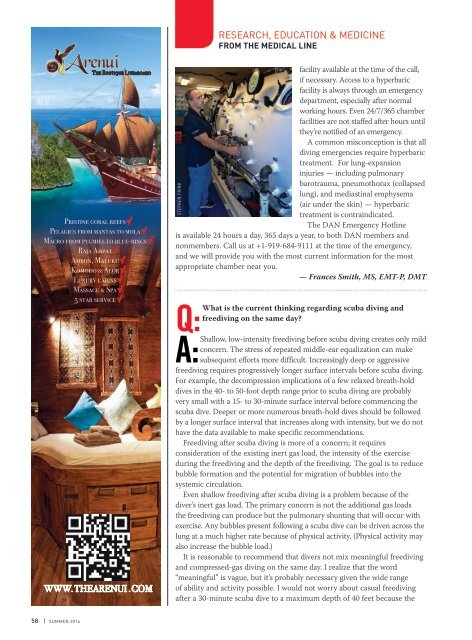AD 2016 Q3
Alert Diver is the dive industry’s leading publication. Featuring DAN’s core content of dive safety, research, education and medical information, each issue is a must-read reference, archived and shared by passionate scuba enthusiasts. In addition, Alert Diver showcases fascinating dive destinations and marine environmental topics through images from the world’s greatest underwater photographers and stories from the most experienced and eloquent dive journalists in the business.
Alert Diver is the dive industry’s leading publication. Featuring DAN’s core content of dive safety, research, education and medical information, each issue is a must-read reference, archived and shared by passionate scuba enthusiasts. In addition, Alert Diver showcases fascinating dive destinations and marine environmental topics through images from the world’s greatest underwater photographers and stories from the most experienced and eloquent dive journalists in the business.
Create successful ePaper yourself
Turn your PDF publications into a flip-book with our unique Google optimized e-Paper software.
RESEARCH, EDUCATION & MEDICINE<br />
FROM THE MEDICAL LINE<br />
The Boutique Liveaboard<br />
Pristine coral reefs √<br />
Pelagics from mantas to mola √<br />
Macro from pygmies to blue-rings √<br />
Raja Ampat √<br />
Ambon, Maluku √<br />
Komodo & Alor √<br />
Luxury cabins √<br />
Massage & Spa √<br />
5 star service √<br />
WWW . THEARENUI . COM<br />
facility available at the time of the call,<br />
if necessary. Access to a hyperbaric<br />
facility is always through an emergency<br />
department, especially after normal<br />
working hours. Even 24/7/365 chamber<br />
facilities are not staffed after hours until<br />
they’re notified of an emergency.<br />
A common misconception is that all<br />
diving emergencies require hyperbaric<br />
treatment. For lung-expansion<br />
injuries — including pulmonary<br />
barotrauma, pneumothorax (collapsed<br />
lung), and mediastinal emphysema<br />
(air under the skin) — hyperbaric<br />
treatment is contraindicated.<br />
The DAN Emergency Hotline<br />
is available 24 hours a day, 365 days a year, to both DAN members and<br />
nonmembers. Call us at +1-919-684-9111 at the time of the emergency,<br />
and we will provide you with the most current information for the most<br />
appropriate chamber near you.<br />
— Frances Smith, MS, EMT-P, DMT<br />
STEPHEN FRINK<br />
Q:<br />
What is the current thinking regarding scuba diving and<br />
freediving on the same day?<br />
A:<br />
Shallow, low-intensity freediving before scuba diving creates only mild<br />
concern. The stress of repeated middle-ear equalization can make<br />
subsequent efforts more difficult. Increasingly deep or aggressive<br />
freediving requires progressively longer surface intervals before scuba diving.<br />
For example, the decompression implications of a few relaxed breath-hold<br />
dives in the 40- to 50-foot depth range prior to scuba diving are probably<br />
very small with a 15- to 30-minute surface interval before commencing the<br />
scuba dive. Deeper or more numerous breath-hold dives should be followed<br />
by a longer surface interval that increases along with intensity, but we do not<br />
have the data available to make specific recommendations.<br />
Freediving after scuba diving is more of a concern; it requires<br />
consideration of the existing inert gas load, the intensity of the exercise<br />
during the freediving and the depth of the freediving. The goal is to reduce<br />
bubble formation and the potential for migration of bubbles into the<br />
systemic circulation.<br />
Even shallow freediving after scuba diving is a problem because of the<br />
diver’s inert gas load. The primary concern is not the additional gas loads<br />
the freediving can produce but the pulmonary shunting that will occur with<br />
exercise. Any bubbles present following a scuba dive can be driven across the<br />
lung at a much higher rate because of physical activity. (Physical activity may<br />
also increase the bubble load.)<br />
It is reasonable to recommend that divers not mix meaningful freediving<br />
and compressed-gas diving on the same day. I realize that the word<br />
“meaningful” is vague, but it’s probably necessary given the wide range<br />
of ability and activity possible. I would not worry about casual freediving<br />
after a 30-minute scuba dive to a maximum depth of 40 feet because the<br />
58 | SUMMER <strong>2016</strong>









